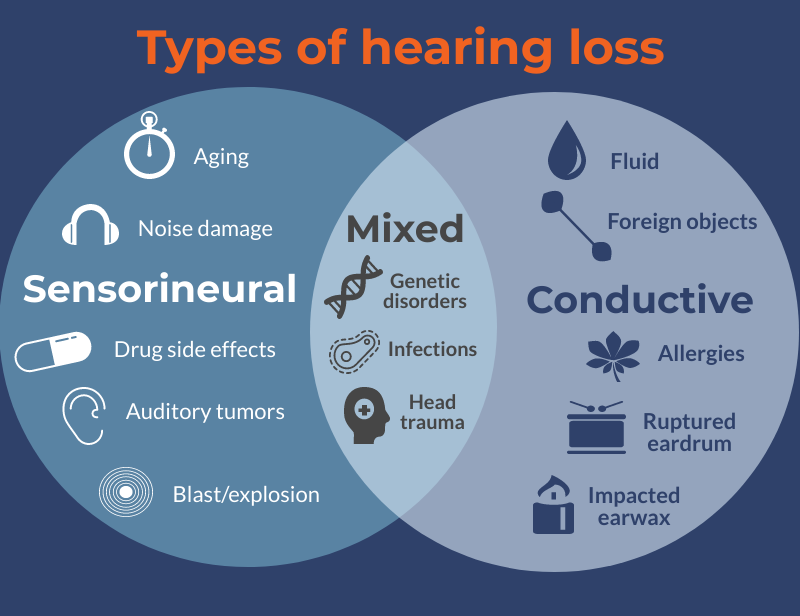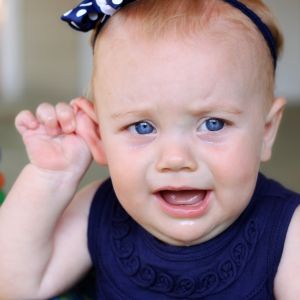The main types of hearing loss are sorted into three categories:
- Sensorineural hearing loss, which means there is a problem occurring in either the inner ear or the auditory nerve, which delivers sound to the brain.
- Conductive hearing loss, which means sound is not reaching the inner ear, usually due to an obstruction or trauma.
- Mixed hearing loss means the hearing loss is being caused by a combination of the two.

Illustration credit Hough Ear Institute
Table of Contents
Sensorineural hearing loss
The most common type of hearing loss is sensorineural. It is a permanent hearing loss that occurs when there is damage to either the tiny hair-like cells of the inner ear, known as stereocilia, or the auditory nerve itself, which prevents or weakens the transfer of nerve signals to the brain. These blocked nerve signals carry information about the loudness and clarity of sounds.
Causes

of hearing loss you have.
If a child is born with sensorineural hearing loss, it is most likely due to a genetic syndrome or an infection passed from mother to fetus inside the womb, such as toxoplasmosis, rubella or herpes.
When sensorineural hearing loss develops later in life—which is more typical—it can be caused by a wide variety of triggers.
Most common causes:
- Normal aging (known medically as presbycusis, or age-related hearing loss)
- Exposure to loud noises, often acquired on the job
Less common causes
- Heart diseases and diabetes
- Infections such as mumps
- Meniere’s disease
- A side effect from medicines
- Acoustic neuroma or other cancerous growths in the inner ear
- Traumatic injuries that damage the inner ear or auditory nerve
- Autoimmune diseases
Symptoms
The symptoms of sensorineural hearing loss affect both the loudness and the clarity of sounds. For many people, they will have high-frequency hearing loss, resulting in the following issues with hearing:
- Speech of others may seem slurred or mumbled, or, a feeling of you can hear but not understand
- Difficulty following a conversation when two or more people are speaking at the same time
- A consistent ringing or buzzing in the ears (tinnitus)
- Problems listening in noisy environments (e.g. train stations, construction sites, convention centers, sports arenas, etc.)
- Difficulty hearing women’s or children’s voices and other high-pitched sounds
- Certain speech sounds are difficult to hear during conversations (e.g. the “s” or “th” sound)
- Noises may seem too loud or too quiet (yes, too loud!)
- A feeling of being off-balance or dizzy
People with sensorineural hearing loss often say they can hear people speaking, just not clearly.
Treatment
There is no medical or surgical method of repairing the tiny hair-like cells of the inner ear or the auditory nerve if they are damaged. However, sensorineural hearing loss can be treated with hearing aids or cochlear implants, depending on the severity of the loss.
Assistive listening devices, like alerting devices, vibrating alarm clocks and captioned phones help provide a complete hearing solution. For people with severe-to-profound hearing loss, power hearing aids can help.
Conductive hearing loss

cause of temporary conductive hearing
loss.
A less common type of hearing loss is conductive hearing loss, which occurs when there is an obstruction or damage to the outer or middle ear that prevents sound from being conducted to the inner ear. Conductive hearing loss may be temporary or permanent, depending on the cause.
Causes
The causes of conductive hearing loss can be differentiated by which part of the ear they affect—either the outer or middle ear:
Outer ear
- Stenosis or a narrowing of the ear canal
- Wax impaction
- Exostoses (bone-like protrusions that can develop inside the ear canal and cause potential cause blockages)
- Otitis externa (also known as swimmer’s ear)
- Obstructions caused by foreign bodies inserted into the ear
- Microtia
Middle ear
- A breach in the tympanic membrane (ear drum) caused by injury, ear infections or extreme and rapid air pressure changes
- Tympanosclerosis, a thickening of the tympanic membrane
- Otitis media (ear infection) and/or a buildup of fluid in the middle ear
- Blockages in the Eustachian tube, which connects the middle ear to the back of the nose and throat
- Otosclerosis, which affects the tiny middle ear bone known as the stapes
- Abnormal growths or tumors that form within the middle ear, such as cholesteatoma or glomus tumors
- Ossicular chain discontinuity, or a break in the connection between the bones of the middle ear, caused by injury or heavy trauma
Symptoms
Because the sensitive inner ear and auditory nerve are intact, an individual suffering from conductive hearing loss primarily has difficulty with the overall loudness of sounds, but not the clarity. Individuals with this kind of loss often find that turning up the volume of the radio or television is all it takes to improve their ability to hear. The following symptoms are also consistent with this type of loss:
- Easier time hearing out of one ear than the other
- Pain in one or both ears
- Sensation of pressure in one or both ears
- Difficulty or frustration with telephone conversations
- A foul odor coming from the ear canal
- A feeling that one’s own voice sounds louder or different
Treatment
There are sometimes medical or surgical treatments that can improve the hearing ability for those with conductive hearing loss. For example, conductive losses caused by wax impaction, foreign objects, abnormal growths or ear infections can often be corrected with medical treatments, like extraction of earwax, antibiotics or surgical procedures.
Conductive hearing losses caused by other abnormalities, like stenosis of the ear canal, exostoses, otosclerosis and ossicular chain discontinuity are more difficult to treat medically and may be considered a permanent hearing loss. These conductive losses may be treated with either standard hearing aids or bone-anchored implantable devices.
Mixed hearing loss
Mixed hearing loss is any combination of sensorineural and conductive hearing loss.
Causes
Mixed hearing loss commonly occurs when the ear sustains some sort of trauma. It also can happen gradually over time when one hearing loss is compounded by another. For example, a person with a long-standing conductive hearing loss might experience age-related hearing loss as they age. Alternatively, a person with age-related hearing loss may have a temporary mixed hearing loss due to wax impaction. Blast injuries or other types of trauma can cause both sensorineural and conductive hearing loss.
Symptoms
The symptoms of mixed hearing loss will be some combination of those listed above for the other two types of hearing loss.
Treatment
Treatment options for mixed hearing loss will depend on whether the loss is more sensorineural or conductive in nature. If a greater portion of the loss is caused by a conductive component, surgical procedures and other medical treatments might be more effective in correcting the hearing concerns. If a greater portion of the loss is sensorineural, hearing aids or implantable devices may be the best option.
Single-sided deafness
Some people are born with hearing in only one ear. In other cases, a person may lose hearing in one ear as a child or adult. All types are collectively known as single-sided deafness. The cause can be sensorineural or conductive, and treatment varies depending on what’s causing the hearing loss and how long a person has had it.
Sudden hearing loss
If this type of hearing loss develops suddenly, seek help promptly. Fast treatment is vital to maintain your hearing or keep it from getting worse.
How to get help
If you or a loved one has a hearing loss, visit our directory of consumer-reviewed hearing clinics to find a professional right away. He or she will investigate the cause and suggest treatment options to suit your needs. Many conductive and mixed hearing losses can be treated medically and nearly all types of hearing loss is treatable with hearing aids, implantable devices and/or assistive listening devices.



